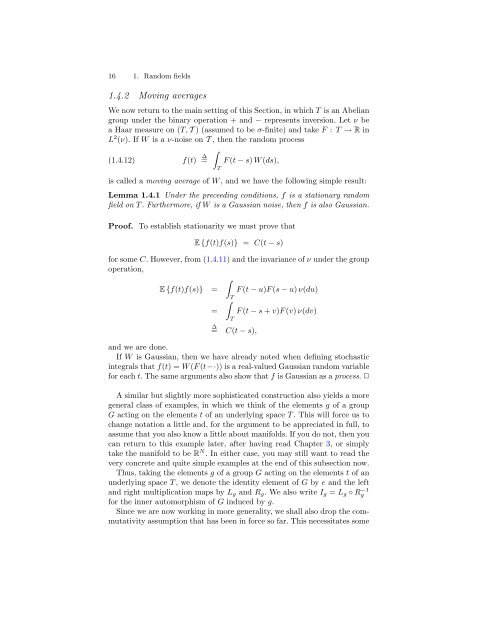You also want an ePaper? Increase the reach of your titles
YUMPU automatically turns print PDFs into web optimized ePapers that Google loves.
16 1. Random fields<br />
1.4.2 Moving averages<br />
We now return to the main setting of this Section, in which T is an Abelian<br />
group under the binary operation + and − represents inversion. Let ν be<br />
a Haar measure on (T, T ) (assumed to be σ-finite) and take F : T → R in<br />
L2 (ν). If W is a ν-noise on T , then the random process<br />
f(t) ∆ �<br />
(1.4.12)<br />
= F (t − s) W (ds),<br />
T<br />
is called a moving average of W , and we have the following simple result:<br />
Lemma 1.4.1 Under the preceeding conditions, f is a stationary random<br />
field on T . Furthermore, if W is a Gaussian noise, then f is also Gaussian.<br />
Proof. To establish stationarity we must prove that<br />
E {f(t)f(s)} = C(t − s)<br />
for some C. However, from (1.4.11) and the invariance of ν under the group<br />
operation,<br />
�<br />
E {f(t)f(s)} = F (t − u)F (s − u) ν(du)<br />
T �<br />
= F (t − s + v)F (v) ν(dv)<br />
T<br />
∆<br />
= C(t − s),<br />
and we are done.<br />
If W is Gaussian, then we have already noted when defining stochastic<br />
integrals that f(t) = W (F (t−·)) is a real-valued Gaussian random variable<br />
for each t. The same arguments also show that f is Gaussian as a process. ✷<br />
A similar but slightly more sophisticated construction also yields a more<br />
general class of examples, in which we think of the elements g of a group<br />
G acting on the elements t of an underlying space T . This will force us to<br />
change notation a little and, for the argument to be appreciated in full, to<br />
assume that you also know a little about manifolds. If you do not, then you<br />
can return to this example later, after having read Chapter 3, or simply<br />
take the manifold to be RN . In either case, you may still want to read the<br />
very concrete and quite simple examples at the end of this subsection now.<br />
Thus, taking the elements g of a group G acting on the elements t of an<br />
underlying space T , we denote the identity element of G by e and the left<br />
and right multiplication maps by Lg and Rg. We also write Ig = Lg ◦ R−1 g<br />
for the inner automorphism of G induced by g.<br />
Since we are now working in more generality, we shall also drop the commutativity<br />
assumption that has been in force so far. This necessitates some
















